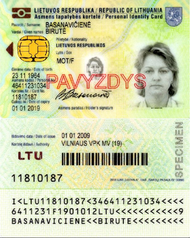Lithuanian identity card
Lithuanian Personal Identity Card is officially recognised identity document issued to Lithuanian citizens.
| Lithuanian identity card | |
|---|---|
 The front and reverse of a 2nd generation (2009-2012) Lithuanian identity card | |
| Type | Identity card |
| Issued by | |
| Valid in | |
Use
As an international travel document
The Personal Identity Card is a limited travel document, valid for travel within most European nations.
As personal identification
Aside from being unable to be used for international travel to other than previously mentioned countries, the passport card is treated as a passport for all other purposes. A Personal Identity Card can be used as primary evidence of Lithuanian citizenship, just like a passport and can be used as a valid proof of citizenship and proof of identity both inside and outside Lithuania
As electronic signature device
Since 2009, Personal Identity Cards are equipped with contact chips, allowing their usage as digital signature devices with a smart card reader. The Identity documents personalisation centre under the Lithuanian Ministry of the Interior provides digital signature software for Windows, Linux and Mac OS environments.
History
First Lithuanian Personal Identity Cards were issued in January, 2003. The issuance of these card continued until January, 2009, when they were superseded with biometric and digital signature-capable 2nd generation personal identity cards. In July, 2012 issuance of slightly altered 3rd generation personal identity cards has started.